#Saito Kazuo
Explore tagged Tumblr posts
Text
LONE WOLF AND CUB: BABY CART IN PERIL
Hunt tattooed lady
Boy gets lost with performers
Rival seeks vengeance
youtube
#lone wolf and cub#baby cart in peril#random richards#poem#haiku#poetry#haiku poem#poets on tumblr#haiku poetry#haiku form#criterion collection#criterion channel#ogami itto#tomisaburo Wakayama#Yoichi Hayashi#Michi Azusa#Akihiro Tomikawa#buichi saito#Kazuo Koike#Goseki Kojima#Youtube
0 notes
Note
questions from the manga ask post by tomoyoo:
1. your top reads of 2024
17. a manga you weren't expecting to like
20. what's your 2025 reading list?
1: Top reads of 2024 - This is really hard tbh, this year I sort of restarted reading manga bc I'd been stagnant for like the last few years so there's a few..... some standouts would def be My Name is Shingo and Baptism by Kazuo Umezu, The Inheritance of Aroma by Nakamura Asumiko, Keiko Takemiya's Sunroom Nite short story collection, Offshore Lightning by Saito Nazuna, and Yoshida Akimi's California Monogatari 17: Manga you weren't expecting to like - This is also insanely hard for the sole reason that I generally don't read manga I expect to dislike 😭 especially because I buy a lot of the manga I read in physical volumes so I really rarely go into buying a series with negative expectations? Maybe NO expectations is more common for me idk....more often than not I am let down by BL manga LMFAO so maybe some of those but tbh no manga really stick out in my memory 20: 2025 reading list - I REALLY want to read A Cruel God Reigns so I hope to try that next year but damn it is long. Lmfao. Ik that's not the typical issue with it but omfg I struggle to get through longer series. I want to reread The Poe Clan and Kazeki in the new year just because they are long and frankly my memory is insanely short term lol...In terms of new stuff tho I still need to read Oniisama E and I want to read Naka Tomoko's Fashion Fade as well. And as always more BL, whatever meets my preference really. I have a bunch on my mangadex plan to read lol
15 notes
·
View notes
Text






Beijing Watermelon (Nobuhiko Obayashi, 1989)
Cast: Bengal, Masako Motai, Yasufumi Hayashi, Haruhiko Saito, Takashi Sasano, Hana Kino, Akira Emoto, Yugi Ogata, Ryo Okubo, Ryo Iwamatsu, Kazunori Hagiwara, Hiromi Oshima. Screenplay: Yoshihiro Ishimatsu. Cinematography: Shigekazu Nagano. Production design: Kazuo Satsuya. Music: Tetsuo Kondo.
3 notes
·
View notes
Text
Extreme Bath Log Disk 1 – Track 3: Genjo Family’s Evening
Click here to listen to the track on youtube.
Click here for translations of previous tracks.
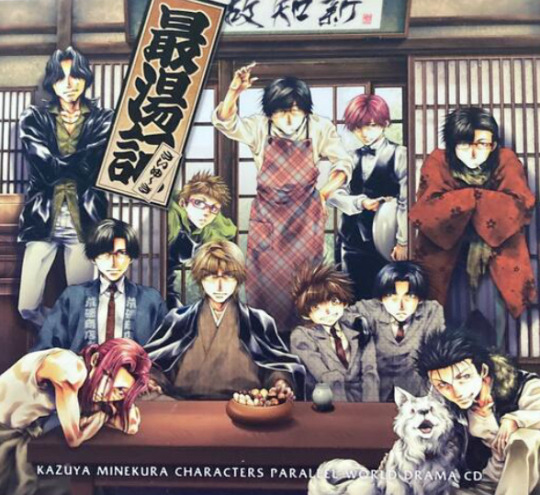
Summary: Goku spent the evening playing video games with his friends from school, Tokito and Saito. Kubota arrived to fetch Tokito home and deliver a piece of news from the neighborhood association. The Genjo family discussed their participation in a local event meant to both celebrate Tanabata and revive the shopping district.
--------
(Music playing in the background. Someone knocks at the door.)
Goku (munching on something crunchy): Yes?
Saito: Excuse me! (slides the door open)
Goku: Oh, Mikawaya-chan!
Tokito: You came just at the right time, Sabu-chan!
Saito: I’m neither Mikawaya nor Sabu-chan! I’m Saito, the seventeen-year old handsome heir of Saito Liquor Store, Saito Kazuo!
Tokito: It’s probably because Mikawaya or Sabu-chan is a more likely name for a deliveryman for a liquor store [that we keep calling your those].
Goku: What is it, Saito? Are you done with work for today already?
Saito: When I arrived at the Genjo residence for my last delivery, I heard that you guys were hanging out on the second floor. I thought I’d come up and say hi. Oh! Isn’t this a new title from MGS? [MGS: Metal Gear Solid - thanks @hokuton-punch !]
Tokito: Have you gotten through this one too?
Saito: I’m in the midst of collecting the trophies. This is the second week.
Goku: Seriously? That’s just like you. Ah, how do I get past this field?
Saito: Okay, could you please call up the map?
Goku: Right.
(The gaming console emits a beep as he calls up the map.)
Saito: Here and here, there are some mercenaries standing guard. This here is the shortest route, but it’s easier to advance by taking a longer path and take down the enemies one by one in close quarters combat.
Tokito: See? That’s exactly what I said.
Goku: Eh? But I’m bad at taking cautious actions, even in video games.... Ah, I'll just give it a pass!
Tokito: Eh? Do I have to be the one to play through this part again? Also, I’ve told you not to touch the controller while eating potato chips, Goku. It’s sticky all over!
Goku: I don’t mind since it’s my controller. By the way, since Saito’s here, let’s play Bomberman or Marica. [https://tvtropes.org/pmwiki/pmwiki.php/VideoGame/MaricaShinjitsuNoSekai]
Saito: Whichever game it is, I accept the challenge!
Tokito: Oh, you’re sure raring to go, Mikawaya!
Saito: It’s Saito!
--------
(Sounds of insects chirping.)
Goku (from upstairs): Ah! Who left a banana here?
Tokito: It was you.
Saito: I’ll go ahead of you guys, okay?
(Goku groans in frustration.)
Hakkai: Whenever Saito-kun joins in, it gets even livelier than usual. I hope they’re not disturbing Tenpou at his work.
Sanzo (slurps noisily at his tea): It’s a regular occurrence. He’s probably used to it after living here for many years.
(The doorbell chimes.)
Hakkai: Coming! Who is it?
Kubota: Hello. I’m from Kubota Laundry.
Hakkai (slides the door open): Ah, good evening Kubota-san.
Kubota: First of all, I’m here to hand these over: the empty food containers** and Mr. Genjo’s laundered clothes. [Kubota, Tokito and Tenpou address Sanzo as go-inkyo, lit. Mister Retiree, which does not sound as reverential as go-inkyo, so I decided to go with ‘Mr. Genjo.’]
Hakkai: Sorry for having you come here just to deliver them. I could’ve gone over to your place to retrieve them myself.
Kubota: It’s no trouble. I’m passing around these bulletins from the neighborhood association anyway, so I took the opportunity to stop by.
Hakkai: I appreciate your efforts. Tokito-kun’s upstairs, you know.
Kubota: Thanks for having him – he’s always visiting you. I hope he’s not too much of a nuisance. I’m also here to fetch him home. Tokito, it’s time to leave.
Tokito (from upstairs): Okay! Gimme a minute!
Hakkai: That’s right – the homepage that Tokito-kun made for us is amazingly popular. Sorry for having him do this without compensation.
Kubota: We’re in your debt too. The macaroni salad was very delicious. Those piquant black peppers really go well with beer. The two of us polished it off in an instant.
Hakkai: I’m glad to hear that. The salad is also popular among the members of this household.
(A door slides open upstairs.)
Goku: See you tomorrow.
Tokito: Yeah. (runs down the stairs) Sorry for the wait, Kubo-chan.
Kubota: We’ll be taking our leave then, Genjo-san,.
Tokito: See you!
Hakkai: Good night. (closes the door)
Hakkai (to himself): Genjo-san, eh? At any rate, ‘Genjo Hakkai’ sounds considerably pretentious as a name. Well, at least it’s far from being as odd-sounding as ‘Genjo Gojyo.’
--------
(Gojyo sneezes. In the background, there are sounds of water being splashed and dribbling down the floor.)
Gojyo: Really. Why are all the customers middle-aged men and old geezers whenever it’s my turn to man the attendant’s booth? Even if the changing room is not visible from here, at least the sight of some beautiful women in after-bath yukata would cheer me up. [yukata: light cotton kimono worn in the summer or used as a bathrobe]
(A bell rings as the door slides open.)
Gojyo: Ah, welcome– oh, it’s just the old man from the grocery store.
Old man: So the eldest son’s manning the attendant's booth today. Looks like you’ve been putting in a decent amount of work recently. Here’s the key for safekeeping. (walks away after putting the key to his locker on the counter)
Gojyo: What a let down.
--------
Goku: Ah, it’s hot! A cold drink of milk is best after a bath! Eh? Are you going out, Gojyo?
Gojyo: After a full day of working, I now have to leave for my part-time job. (yawns)
Sanzo: Those were all easy stuff, so don’t let them get the best of you.
Hakkai: Ah, since everyone’s gathered here, could I have a bit of you time? There’s something I’d like to consult you regarding the bathhouse.
Goku: Consult?
Sanzo: Did something happen?
Hakkai: No, it’s not that. A short while ago, bulletins announcing the outcome of the neighborhood association meeting has been circulated. Here’s our copy. (places a piece of paper on the table)
Gojyo: Mmm, what’s this? ‘Araiso Shopping District?’
Sanzo (reads from the bulletin): ‘Tanabata Festival: Decision on the Event to Hold?’ [https://en.wikipedia.org/wiki/Tanabata]
Goku: Eh, so they’re going to organize a festival.
Hakkai: Even though they say it’s a festival, rather than food stalls at the temple or all-night folk dances, apparently the event they’re going to hold is a three-day stamp rally throughout the shopping district. [https://en.japantravel.com/guide/introduction-to-stamp-rallies/46627]
Gojyo: What’s that?
Hakkai: Ever since a large-scale shopping center opened in front of the train station, the businesses in this shopping district have been having a tough time in various ways. They’ve been talking for a while about holding such a community-based event to earnestly promote the shopping district and regain the customers.
Goku: Let me see.... (reads from the bulletin) ‘During the three days of the event, each shop in the shopping district is to provide the customers with original free services or freebies associated with Tanabata.’
Sanzo (continues reading): ‘Regarding items associated with Tanabata, foodstuffs, novelty mahjong score sheets **, games or events – anything is fine.’ Hah. That’s an awfully sloppy description.
Hakkai: That’s because the chairperson of the neighborhood association is fairly sloppy person herself.
Goku: The chairperson is that person, right? Granny Sharak, grandpa’s senior who runs the long-established Japanese-style confectionery store?
Gojyo: If you call her Granny to her face, you’ll get a hundred energetic lashes from that wild old woman.
Hakkai: Our bathhouse is quite a long-established business among the shops in this shopping district, so we’ll have to participate in this event. Father can’t afford to make Sharak-san lose face as well.
Sanzo: That woman’s harshly made me accompany her on her rounds of heavy drinking since the old days.
Gojyo: But, we’re running a bathhouse. What sort of Tanabata-related service should we offer?
Hakkai: That’s what I’d like to get everyone’s advice on.
Goku: Hm-mm.... how about setting up some bamboos by the bathtubs? [for the customers to hang colorful pieces of paper on, after writing their wishes for the year on those pieces of paper]
Gojyo: If those sharp leaves were to become loose and fall, they’d cover the whole surface of the water and no-one would be able to move in the bath.
Sanzo: The customers would probably be pleased – if they were pandas.
Hakkai: Decorating the interior of the bathhouse is a good idea by itself... hmm, but exposing the customers’ bare skin to bamboo leaves in the bathhouse is a bit risky.
Goku: Then, since we’re running a bathhouse, how about handing out hot spring steamed buns? [onsen-manju: buns stuffed with azuki-bean paste sold in towns and resorts of hot springs]
Hakkai: Wouldn’t it be a false representation to call those ‘hot spring steamed buns?’ [since the Genjo bathhouse does not use a hot spring as their water source.]
Gojyo: Would anyone be delighted to eat steamed buns right after coming out of the bath?
Sanzo: They would be, at least somewhat.
Gojyo: Damn old geezers with a sweet tooth should just keep their mouths shut.
Sanzo: Keep my mouth shut, you say? I’m the owner of this bathhouse, you good-for-nothing!
Gojyo: You're one to talk! Haven’t you gone into retirement a long time ago and left the running of the bathhouse completely to Hakkai?
Sanzo: Hah?
Gojyo: What is it? Bring it on!
Goku: Jeez, what are you guys doing? Stop fighting and think seriously over this Tanabata event!
Hakkai: Goku has really become dependable, hasn’t he? For the time being, since we need to report what we plan to do for the Tanabata event to the neighborhood association in one week’s time, let’s come up with something until then. The two of you, please lend your support for a bit as well, okay?
Gojyo: Yeah, yeah, I got it.
Sanzo: Hmmph.
Hakkai: Well then, I need to get back to work. Please be careful when putting out the fire**, Father. [I listened to this for a few times before concluding that in Hakkai’s absence, Sanzo probably has a tendency to set things on fire when lighting up a cigarette or something....]
Goku (sounding excited): Tanabata Festival, huh? I’m sure looking forward to it....
--------
(Round brackets): actions and sound effects. [Square brackets]: translator’s notes or clarifications. Double asterisks **: Stuff I am not sure with. Suggestions for improvements and corrections are more than welcome.
19 notes
·
View notes
Text
works that have shaped saito asuka:
film
- wim wenders's "perfect days" (2023)
- hiroshi teshigahara's "woman in the dunes" (1964)
- kō nakahira's "only on mondays" (1964)
literature
- kenzaburo ōe's "lavish are the dead" (1958)
- kiyoshi shimizu's "the murderer is there: the cover-up of northern kanto's serial kidnap-murders" (2013)
- ryū murakami's "in the miso soup" (1997)
- keigo higashino's "birdman plan" (1989)
- kazuo ishiguro's "when we were orphans" (2006)
music
- frank sinatra's "my way" (1969)
- noriyuki makihara's "boku ga ichiban hoshikatta mono" (2004)
- mr. children's "simple" (1999)
0 notes
Text
Another year of Saito being my profile pic. Although this one is for twitter, imma just make another one for tumblr (still going to be Saito)
Edit: He isn’t my tumblr anymore, still he’s on twitter




2 notes
·
View notes
Text
Caved and brought Lobotomy Corporation cuz it was on sale.
Unfortunately, with how terrible I am at management games and how stressful it can be, I probably won’t be playing it too much jshwubuq
Anyway, my current employees/agents. Mostly consists of my own’s and Aphan’s characters

(Warning though, LC is a horror game, so there’s a lot of nasty stuff.)
9 notes
·
View notes
Text
today's megane is: Saito Kazuo from Bus Gamer

2 notes
·
View notes
Text



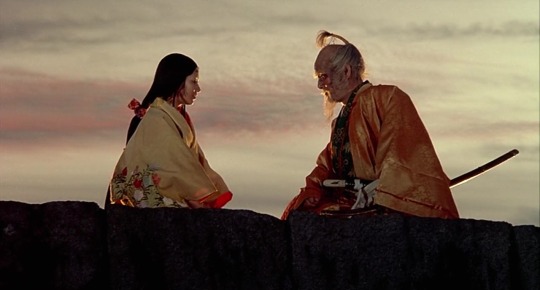

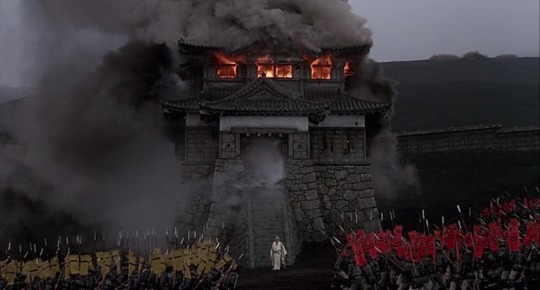
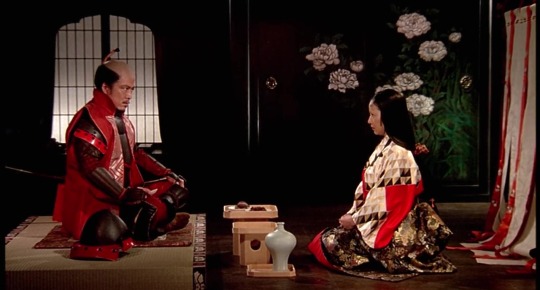

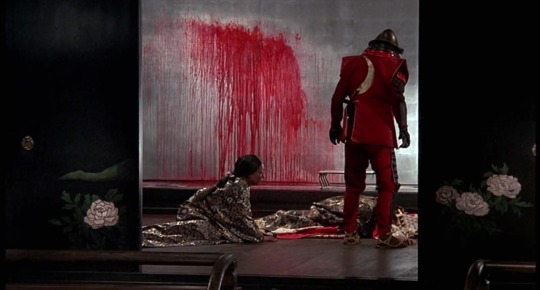
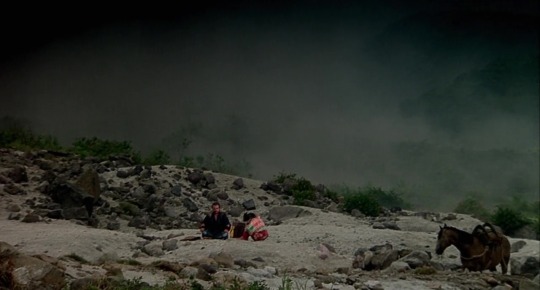
RAN (1985)
Director - Akira Kurosawa, Cinematography - Takao Saito, Masaharu Ueda & Asakazu Nakai
"In a mad world only the mad are sane."
#scenesandscreens#ran#akira kurosawa#Takao Saito#Masaharu Ueda#Asakazu Nakai#mansai nomura#Masayuki Yui#Kazuo Kato#Jun Tazaki#Hitoshi Ueki#Daisuke Ryu#Mieko Harada#Peter#Hisashi Igawa#Yoshiko Miyazaki#tatsuya nakadai#akira terao#Jinpachi Nezu
75 notes
·
View notes
Text






Mimasaka siblings imitating other triple siblings Pt. 2
This time it‘s triple sibs from their verse and I hope you can tell who it is
#its the Saito-Sisters in the first row and as you can see by the glasses in the second row thats the Eizan-Brothers#Ran Mimasaka#Kazuo Mimasaka#Ayano Mimasaka#Lea is doing Art
6 notes
·
View notes
Photo
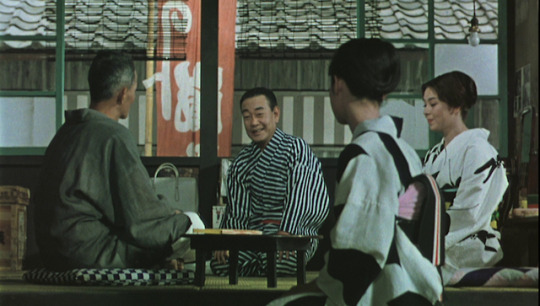
Floating Weeds (1959, Japan)
Director Yasujirô Ozu was tardy to synchronized sound in movies. With the introduction of sound in 1927, he did not make his first talkie until 1936. So too was he tardy with color. With black-and-white and color movies released together for decades, Ozu’s first color film came with Equinox Flower (1958), followed by Good Morning (1959; a remake of Ozu’s 1932 film I Was Born, But...). Later in 1959 another Ozu color talkie remake of one of his black-and-white silent films came to Japanese theaters: 1959′s Floating Weeds, a remake of A Story of Floating Weeds (1934). An already great original version is made better in this instance thanks to beautiful on-location shooting and a more mischievous sense of humor. In one of his most accessible pieces in his filmography, the cast includes many newer faces in this Ozu film. This is because Ozu’s contract with his home studio, Shochiku, had completed, and this next project was thanks to an invitation by Masaichi Nagata – the president of Daiei Film. Floating Weeds is made up largely of Daiei’s contracted actors, with one notable exception being Ozu mainstay Chishû Ryû.
Shot on the edge of the Kii Peninsula looking into Japan’s Inland Sea, Floating Weeds is a late-career testament to Ozu’s remarkable consistency as a director and storyteller, a crafter of dramas as compelling any drama could be – even when all the “showier” moments are never depicted, only discussed.
It is a sweltering summer in a lazy seaside town, with the occasional fishing vessel making its way through the harbor. A traveling kabuki troupe has arrived and they announce their new slate of shows with an impromptu parade and music. The troupe’s leader, Komajuro Arashi (Ganjirô Nakamura), is here not only to perform, but to see his old mistress, Oyoshi (Haruko Sugimura), and college-bound son, Kiyoshi (Hiroshi Kawaguchi). Oyoshi runs an intimate restaurant while Kiyoshi works at the local post office, building his savings before heading to university. Kiyoshi is told that Komajuro is his uncle – a secret that is threatened when Komajuro’s current mistress, Sumiko (Machiko Kyô), becomes jealous as he is not spending enough time with her during the daytime before performances. The film features a younger troupe actress named Kayo (Ayako Wakao) and the theater owner (Ryû). Character actors Kôji Mitsui and Haruo Tanaka also play bit roles.
The screenplay, co-written by Ozu and partner-in-crime Kôgo Noda, leans into the melodrama moreso than most Ozu films. Central to Floating Weeds are its characters speaking about permanence and belonging – like the original silent film version, the title is derived from the saying, “Floating weeds, drifting down the leisurely river of our lives.” For this film’s characters, it is difficult to always be traveling, living within the mercy of ticket sales, although the company of fellow troupe members makes the difficulty worth it. Komajuro is not an authoritarian boss to his fellow actors, but he is unable to see situations through others’ perspectives. Why are they not more like me, he wonders, as he is repeatedly surprised that the other members of his troupe imagine what life could be like without traveling across Japan. He cares for his fellow actors to the extent that everyone depends on each other for their roaming lifestyle. To his “nephew”, secrets remains unspoken behind an avuncular act that occurs every few years – Komajuro does not want Kiyoshi to follow or replicate a life that is dependent, rootless. It is how he remains Kiyoshi’s father, because he knows of no other way to do so. This concentration on Komajuro does come at the partial expense of understanding Oyoshi. It is no debate that she has been a wonderful mother to her son, but she is essentially a single parent that receives the occasional payment from an absent father. Does she harbor any spurned feelings for this arrangement? Is she content with what life has become or does she yearn for something else? Ozu and Noda never explore this quite enough.
Cinematic ellipsis is found in most of Ozu’s work, leaving the viewer to work together what has occurred in between scenes. Less-experienced Ozu viewers will be caught off-guard, claiming that characters seem to lack motivation, but Ozu has never been one to show the details of a steamy date, pomp and circumstance, or tearful departing words. As Ozu’s career progressed, his use of ellipsis generally increased – he became less interested in narrative flow, more interested in human perceptions and insights at a given moment. When Sumiko’s machinations involving Kayo are revealed to Komajuro and when Oyoshi tells her son about who his “uncle” is, all that has been built up to these dramatic reveals are moments of quiet or lightly reflective conversation. Melodrama here is empowered through objectively-shot conversation, oftentimes casual rumor-mongering or quotidian remarks about how the day has been. The static pillow shots in between scenes (Ozu’s innovation where, after a lengthy scene, he might show us a few seconds of the corner of a building or a shot of the sea’s edge or the neon lights of a narrow street to allow the viewer to reflect on what has just occurred) serve as periods do in writing. The idea of a scene may be picked up later, or maybe it has served its purpose in defining to the viewer the characters who gradually show who they are across the film (and in a handful of cases, minor characters who appear once or twice – to Ozu, even these characters have a significant role to the ideas the film expresses).
There are times where – other than the character names, the setting, the synchronized sound, and the color photography – Floating Weeds seems indistinguishable from A Story of Floating Weeds (the two films have similar opening pillow shots). By 1959, Ozu’s era of experimentation had long since concluded. Ironing out what became his signature style in the 1920s and 1930s, the tatami shot aesthetic (where the camera would be placed low to the ground, pointed slightly upwards) and the pillow shot became his trademarks. The ellipsis was a given (as was passable to terrible child dramatic acting, which Ozu never seemed to improve on – not as if children were essential to Ozu’s dramas). Differentiating between A Story of Floating Weeds and Floating Weeds is that the latter, mostly in its opening half, has a broader sense of humor, playfulness – one running joke, more easily understood by those familiar with Japanese filmmaking or culture at-large, is that this kabuki troupe is depicted as anything but a high-quality entourage. It is a welcome reprieve to what might otherwise have been a hard-hitting domestic drama with no easy resolutions. This might be because that Daiei Film was less associated with melodramas than Shochiku.
In his first Ozu film, cinematographer and Daiei contractee Kazuo Miyagawa (1950′s Rashômon, 1965′s Tokyo Olympiad) always keeps the camera static – as one would also expect from any Ozu feature. It is a beautifully shot movie, perhaps most notably for the following sequence. As Komajuro and Sumiko move in an argument that is carried across the street that separates them, the camera does not pan with them. Notice where the camera is located as the characters speak: not over anyone’s shoulder, but a set distance from each character as they make their points. The second way this is shot has the camera reverting back to showing us part of the rain-splattering street, far back enough so that neither character physically dominates the frame. This latter framing is an extraordinarily complex composition filled with vertical lines that almost threaten the frame’s geometry, but it serves to lend objectivity to the two characters arguing their views – so that cinematography does not have much say in giving unwanted sympathy to either character.
youtube
Composer Takanobu Saitô (1953′s Tokyo Story, Equinox Flower) usually had little of interest to do – musically, cinematically – in his scores for Ozu’s films. Flowing, pastoral string melodies without motifs are typically played over the opening credits. But this is, if only for one cue, an unusual score for Saitô. In the scene where the troupe enters town for the first time, Saitô has composed a cue where the melodies reside in the woodwinds and where percussion is prominent. It is carnival-like music, which may remind some Italian cinema aficionados of the exuberance of Nino Rota’s scores for ‘50s and ‘60s Fellini films.
Lacking the absolute serenity of many Ozu films, Floating Weeds is nevertheless an exemplar of Ozu’s inimitable style and how emotionally and philosophically effective it can be. Because it has more above-the-surface melodrama than most in Ozu’s filmography, Floating Weeds is a possible starting point for any neophytes to a type of filmmaking far removed from exposition-delivering and overt dramatics of mainstream Western cinema (not that all Japanese cinema has bucked Western influences – a vast majority of the most popular contemporary Japanese movies, live-action and animated, take notes from Hollywood and not Ozu). For those who make Floating Weeds their first or one of their first Ozu films, the film serves as an introduction to some of the unifying ideas in his entire filmography. Individual lives are inescapably altered by others. To repudiate or fail to intuit that truth is to invite suffering; to intuit that truth but not attempt to understand others’ actions is hubris.
My rating: 9/10
^ Based on my personal imdb rating. My interpretation of that ratings system can be found here.
#Floating Weeds#Yasujiro Ozu#Ganjiro Nakamura#Machiko Kyo#Ayako Wakao#Hiroshi Kawaguchi#Haruko Sugimura#Hitomi Nozoe#Chishu Ryu#Kogo Noda#Kazuo Miyagawa#Takanobu Saito#TCM#My Movie Odyssey
6 notes
·
View notes
Photo

(1995) Pro Mahjong Kiwame III
where this excels: a beat on top of otherwise chillout tunes.
like holy moly. is this what you call post-rave? music for the cooldown room?
if the entire soundtrack were like this it would be a rec, but sadly it kinda falters a bit, so it’s “merely” good
1 note
·
View note
Text
135 planos que harán que recuperes la fe en el cine
youtube
Un maravilloso vídeo ensayo de hace diez años que en su momento se hizo viral. En el verano de 2012, Flavorwire solicitó a sus lectores que sugirieran aquellas películas que consideraban eran las mejores de la historia del cine. El resultado, un montaje que la revista de cultura editó con los títulos propuestos por sus lectores y que rinde un hermoso homenaje al séptimo arte. Si eres amante del cine, seguro que disfrutarás de los magníficos ocho minutos que dura el montaje de Flavorwire. Las películas de las que se han extraído los planos, en orden de aparición:
Man with a Movie Camera (Mikhail Kaufman), The Assassination of Jesse James by the Coward Robert Ford (Roger Deakins), Baraka (Ron Fricke), Koyaanisqatsi (Ron Fricke), Days of Heaven (Nestor Almendros), Akira Kurosawa’s Dreams (Takao Saito, Shoji Ueda), What Dreams May Come (Eduardo Serra), Legends of the Fall (John Toll), Lawrence of Arabia (Freddie Young), El Topo (Rafael Corkidi), La Dolce Vita (Otello Martelli), The Tree of Life (Emmanuel Lubezki), Daughters of the Dust (Arthur Jafa), Chinatown (John A. Alonzo), Hero (Christopher Doyle), Kagemusha (Takao Saito, Shoji Ueda), The Night of the Hunter (Stanley Cortez), Ugetsu (Kazuo Miyagawa), Songs from the Second Floor (Istvan Borbas, Jesper Klevenas, Robert Komarek), The Black Stallion (Caleb Deschanel), Vertigo (Robert Burks), Manhattan (Gordon Willis), Apocalypse Now (Vittorio Storaro), Lovers of the Arctic Circle (Gonzalo F. Berridi), The Duellists (Frank Tidy), Powaqqatsi (Graham Berry, Leonidas Zourdoumis), Ran (Asakazu Nakai, Takao Saito, Shoji Ueda), Bombay Beach (Alma Har’el), 2001: A Space Odyssey (Geoffrey Unsworth), The Thin Red Line (John Toll), Cave of Forgotten Dreams (Peter Zeitlinger), The New World (Emmanuel Lubezki), Solaris (Vadim Yusov), The Diving Bell and the Butterfly (Janusz Kaminksi), I Am Love (Yorick Le Saux), A Matter of Life and Death (Jack Cardiff), Onibaba (Kiyomi Kuroda), Blue Velvet (Frederick Elmes), No Country for Old Men (Roger Deakins), I Am Cuba (Sergei Urusevsky), The Fountain (Matthew Libatique), There Will be Blood (Robert Elswitt), The Human Condition (Yoshio Miyajima), The Proposition (Benoit Delhomme), Raise the Red Lantern (Lun Yang, Fei Zhao), The Godfather Part II (Gordon Willis), 2046 (Christopher Doyle, Pung-Leung Kwan), Beauty and the Beast (Henri Alekan), Melancholia, (Manuel Alberto Claro), Road to Perdition (Conrad L. Hall), Alexander Nevsky (Eduard Tisse), Sunrise (Charles Rosher, Karl Struss), Blade Runner (Jordan Cronenweth), Citizen Kane (Gregg Toland), House of Flying Daggers (Xiaoding Zhao), Wings of Desire (Henri Alekan), Atonement (Seamus McGarvey), The Last Emperor (Vittorio Storaro), Before Night Falls (Xavier Perez Grobet, Guillermo Rosas), The Last Picture Show (Robert Surtees), The Red Shoes (Jack Cardiff), Down by Law (Robby Müller), Amelie (Bruno Delbonnel), Chungking Express (Christopher Doyle, Wai-keung Lau), Children of Men (Emmanuel Lubezki), Black Orpheus (Jean Bourgoin), The Leopard (Giuseppe Rotunno), The Age of Innocence (Michael Ballhaus), Perfume: The Story of a Murderer (Frank Griebe), Raging Bull (Michael Chapman), The Fall (Colin Watkinson), The Pillow Book (Sacha Vierny), Martha Marcy May Marlene (Jody Lee Lipes), Nosferatu the Vampyre (Jorg Schmidt-Reitwein), The Third Man (Robert Krasker), Good Night and Good Luck (Robert Elswitt), The Scarlet Empress (Bert Glennon), The Man Who Wasn’t There (Roger Deakins), Talk to Her (Javier Aguirresarobe), In The Mood for Love (Christopher Doyle, Pung-Leung Kwan, Ping Bin Lee), The Man Who Cried (Sacha Vierny), Santa Sangre (Daniele Nannuzzi), The Passion of Joan of Arc (Rudolph Maté), In Cold Blood (Conrad L. Hall), 8 ½ (Gianni Di Venanzo), Brazil (Roger Pratt).
_________________ Fuente: Flavorwire.
6 notes
·
View notes
Photo
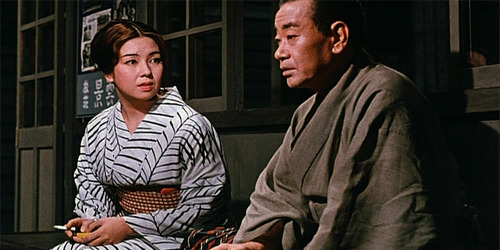
Machiko Kyo and Ganjiro Nakamura in Floating Weeds (Yasujiro Ozu, 1959)
Cast: Ganjiro Nakamura, Machiko Kyo, Ayako Wakao, Hiroshi Kawaguchi, Haruko Sugimura, Hitomi Nozoe, Chishu Ryu, Koji Mitsue, Haruo Tanaka. Screenplay: Yasujiro Ozu, Kogo Noda, based on a screenplay by Tadao Ikeda. Cinematography: Kazuo Miyagawa. Production design: Hideo Matsuyama. Film editing: Toyo Suzuki. Music: Takanobu Saito. The remake of his 1934 silent, A Story of Floating Weeds, Yasujiro Ozu's Floating Weeds adds not only the technological advances of sound and color, but also shows the maturing of Ozu's sensibility. It's clear that the director feels a deep identification with Komajuro (Ganjiro Nakamura), the "master" of the group of traveling players, who finds himself worried not only about his responsibility to the actors but also about his responsibility to his unacknowledged son, Kiyoshi (Hiroshi Kawaguchi), now that the young man is of an age to make the kind of mistakes Komajuro has made. The wonderful Machiko Kyo also brings great depth to the role of Sumiko, an actress in the troupe and Komajuro's current mistress. When she susses out the fact that Komajuro has a former mistress, Oyoshi (Haruko Sugimura), in the town where they're currently performing, and that Kiyoshi is his son by Oyoshi, she takes revenge by having the pretty young actress Kayo (Ayako Wakao) seduce the young man. It's a fairly conventional plot, to be sure, devised for the earlier film by Ozu and Tadao Ikeda, but it reverberates beautifully with the film's theme: a celebration of acting and all that it involves. Komajuro, after all, has been playing the role of Kiyoshi's "uncle," with Oyoshi's aid. And Kayo's acting as the seductress turns into a real love affair. Above all, though, it's the quiet mastery of film that shines through every frame of Ozu's work, made magical by Kazuo Miyagawa's cinematography and Hideo Matsuyama's production design. One of the great works by one of film's great humanists.
3 notes
·
View notes
Text

[Saito Kazuo, the 4th- 3rd agent hired in the facility. He’s not so great when it comes to working with the abnormalities, but he’s a big help in suppressing them.]
15 notes
·
View notes
Text
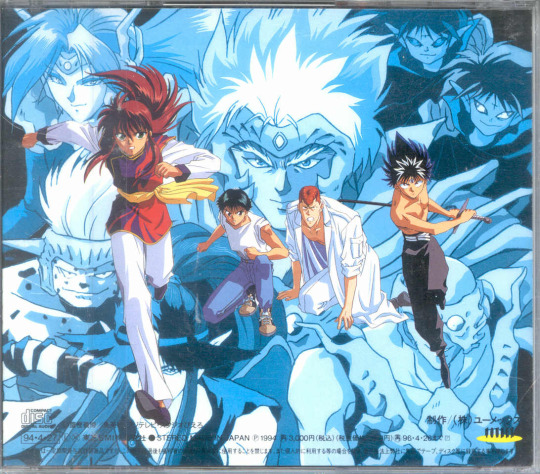
Yu Yu Hakusho: Poltergeist Report released on April 9, 1994.
Studio(s): Studio Pierrot and Movic
Director: Masakatsu Iijima
Producers: Haruo Sai, Ken Hagino, and Naoji Hōnokidani
Score: Yusuke Honma
I'll also list all of the artists involved in making the background art and the key animators! This movie looks incredible and directors tend to get a much bigger cut of the credit than they deserve.
Background Art: Emi Kitahara, Emiko Koizumi, Hideaki Kudo, Hirofumi Shiraishi, Hisae Saito, Hitoshi Nagasaki, Ikuko Ōoka, Kaoru Inoda, Kazuo Ebisawa, Kumiko Nagashima, Masumi Nishikawa, Mio Isshiki, Ryō Kōno, Sadayuki Arai, Sawako Takagi, Shigenori Takada, Shinichi Uehara, Shinobu Takahashi, Shuichi Hirose, Toshiharu Mizutani, Toshiyuki Yoshimura, Yasunari Usuda, Youngil Park, Yuka Kawashima, Yuka Okamoto, Yūko Kobayashi
Key Animation: Akihide Saitō, Chihiro Hayashi, Fuminori Kizaki, Hajime Kamegaki, Hideyuki Motohashi, Hikaru Takanashi, Hiroharu Nishida, Hiromi Niioka, Hirotaka Kinoshita, Hiroyuki Kanbe, Hiroyuki Okuno, Hisahito Natsume, Isao Sugimoto, Junichi Kigawa, Junko Abe, Kari Higuchi , Katsuichi Nakayama, Kazumi Minahiro, Kazuya Kuroda, Kazuyuki Ikai, Kazuyuki Kobayashi, Keiko Shimizu, Kenji Yamazaki, Kunihiko Ito, Mamoru Hosoda, Mamoru Kurosawa, Masahito Yamashita, Masaki Hosoyama, Masayuki Fujita, Mayumi Hirota, Munenori Nawa, Naoyuki Owada, Osamu Nabeshima, Satoru Iriyoshi, Satoshi Fukushima, Shinji Seya, Shinsaku Kōzuma, Shuji Kawakami, Shunji Suzuki, Susumu Yamaguchi, Tadakatsu Yoshida, Tadashi Abiru, Takashi Yamazaki, Takayuki Gorai, Takenori Mihara, Takuya Satō, Toyoaki Shiomi, Yasunari Nitta, Yoshiaki Tsubata, Yoshinori Kanada, Yoshiyuki Kishi, Yuichi Endo, Yuko Kusumoto
54 notes
·
View notes